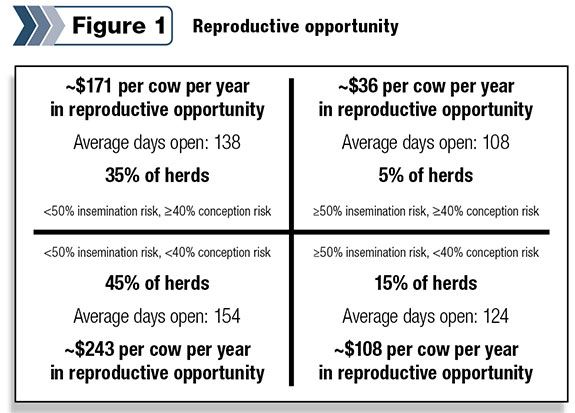This is because pregnancy rate answers the basic question of how many of your open cows are getting bred in a timely fashion. And it tells you if those breedings are getting your cows pregnant.
If you want to improve pregnancy rate, you need to know where the big-picture opportunities for improvement are.
You need to either improve the conception rate of the cows you’re breeding or improve the ability to detect cows in heat. And then, just as important, you need to find out how your herd compares to your neighbours’ herds and other herds in the industry.
So how many herds need to focus on improving conception or insemination rates? How many need to focus on both?

To get a sense of how the industry is performing at the herd level and where opportunities exist, we looked at data from 2,230 CanWest DHI herds that collect good reproductive data.
These herds were divided into four different categories, based on whether they had an opportunity to improve conception rate, improve insemination rate or both.
First, though, we needed to classify what constitutes a low conception or low insemination rate. A herd with a low insemination rate was defined as breeding less than 50 percent of the available open cows waiting to get bred during a year.
A high insemination rate was defined as breeding more than 50 percent of the available open cows during a year.
Although the recommended goal for insemination rate is 60 percent, it was decided to use a lower number to account for different voluntary waiting periods between herds.
A low-conception-rate herd was defined as getting less than 40 percent of cows pregnant after breeding annually.
A high-conception-rate herd was defined as getting more than 40 percent of cows pregnant after breeding annually.
At 40 percent, the conception rate is slightly above the industry average of 37 percent, but this figure is achievable for all dairies.
Low insemination rate – good conception rate
The first group of herds (35 percent of the dairies) had low insemination rates while their conception rate was considered to be good.
The average days open for this group was 138 days with an average economic opportunity of approximately $170 per cow per year. These herds should focus on getting more cows bred.
To get more cows bred in a timely fashion, they need to either spend more time doing visual heat detection, increase the usage of timed A.I. or deploy an activity-monitoring technology.
Most herds with high insemination rates utilize more than one heat detection tool, minimizing the chances of missing any open cows. Also working with your herd veterinarian is very important in order to make sure you’re conducting pregnancy checks at the appropriate frequency.
Low conception rate – good insemination rate
The second group of herds (15 percent of dairies) needed to improve their conception rates, while their insemination rate was considered to be good.
Their average days open was 124 days with an average economic opportunity of approximately $108 per cow per year. For this particular group, the goal would be to focus on ways to improve conception.
Primary areas to focus on would be improving the cow’s fertility through transition, nutrition and environmental management.
As well, they should consider reviewing heat detection and timed-A.I. protocols to make sure timing is being delivered as effectively as possible. For owner inseminator herds, reviewing semen handling and placement on an annual basis is beneficial.
Low conception rate – low insemination rate
The third group of herds (45 percent of dairies) needed to improve both conception and insemination rates.
Their average days open was 154 days with an average economic opportunity of approximately $243 per cow per year.
With opportunities existing in both areas, and with a lot of potential money to be made from an investment in reproductive performance, any investment made that improves both conception and insemination rates will give a great payback.
Interestingly, the data showed that if you had to pick just one area to improve, raising insemination rates gave the better return.
The average days open for herds that have a high insemination rate was 14 days less than the high-conception herds, for an economic difference of approximately $60 per cow per year.
Ideally, you should focus on improving both, but this shows that getting semen into cows by improving your insemination rate can be an effective way to improve your herd’s overall reproductive performance.
Good conception rate – good insemination rate
The fourth and final group of herds (just 5 percent) were considered to have both good insemination and conception rates.
This shows in their low average days open at just 108 days and small economic opportunity of $36 per cow per year. Although this elite group of herds is doing well reproductively, there are always opportunities to improve.
If your herd falls into this category, look at small adjustments in your reproductive program and make sure you are taking full advantage of the genetics you’re using in order to meet your goals.
So what category of herd are you? Take a minute and review your herd averages for conception and insemination rate and see where your herd falls, and if you’re not at the elite level, make the necessary changes to help your herd get there. PD

- Mark Carson
- Reproductive Solutions Manager
- EastGen







